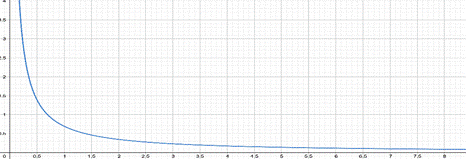
a.
To prove: That it takes
a.
Explanation of Solution
Given information: That it takes
Interest rate r compounded continuously.
Formula used: The amount of money in the account after t year is then
Interest paid according to this formula is said to be compounded continuously. The number r is the continuous Interest rate.
Proof:
The amount of money in the account after t year is then
b.
To graph: Graph the functions
b.
Explanation of Solution
Given information: Graph the functions
Graph:
functions

c.
To calculate: Explain why these two rules of thumb for mental computation are reasonable.
c.
Explanation of Solution
Given information: Use the rules to estimate how long it takes to double money at
Formula used: The amount of money in the account after t year is then
Interest paid according to this formula is said to be compounded continuously. The number r is the continuous Interest rate.
Calculation: the functions
d.
To calculate: Use the rules to estimate how long it takes to double money.
d.
Answer to Problem 46E
Money will double in
Explanation of Solution
Given information: Use the rules to estimate how long it takes to double money at
Formula used: The amount of money in the account after t year is then
Interest paid according to this formula is said to be compounded continuously. The number r is the continuous Interest rate.
Calculation: Use the rules to estimate how long it takes to double money at
The amount of money in the account after t year is then
e.
To calculate: Use the rules to estimate how long it takes to triple money.
e.
Answer to Problem 46E
Money will triple in
Explanation of Solution
Given information: Use the rules to estimate how long it takes to triple money.
Formula used: The amount of money in the account after t year is then
Interest paid according to this formula is said to be compounded continuously. The number r is the continuous Interest rate.
Calculation: Use the rules to estimate how long it takes to double money at
The amount of money in the account after t year is then
Chapter 7 Solutions
Calculus 2012 Student Edition (by Finney/Demana/Waits/Kennedy)
Additional Math Textbook Solutions
Basic Business Statistics, Student Value Edition
University Calculus: Early Transcendentals (4th Edition)
Introductory Statistics
Calculus for Business, Economics, Life Sciences, and Social Sciences (14th Edition)
Elementary Statistics: Picturing the World (7th Edition)
College Algebra with Modeling & Visualization (5th Edition)
- A helicopter pilot needs to travel to a regional airport 25 miles away. She flies at an actual heading of N16.26°E with an airspeed of 110 mph, and there is a wind blowing directly east at 20 mph. (a) Determine the compass heading that the pilot needs to reach her destination. (b) How long will it take her to reach her destination?arrow_forwardQuestion 3. the given integral is convergent or divergent: Use the comparison test to determine whether or not * sin*(x + 1) 7x3 (a) |. d.x g8 + x4 + 1 -dx (b) 2.x4 + x + 1arrow_forward-d.x tan xarrow_forward
- 48. f(x) = { 4 x if x < 2 2x 2 if x 2arrow_forwardГ 49. -x+1 if x 1 Answer ->arrow_forwardA Content X MindTap - Cengage Learning x Function Evaluations x + /ui/evo/index.html?elSBN=9780357038406&id=339416021&snapshotld=877369& GE MINDTAP , Limits, and the Derivative ⭑ វា a ANSWEI 16. Refer to the graph of the function f in the following figure. कर्ट AA C 54 -3-2 7 7 Ay 6. S 5. y=f(x) 4 3. 2. 1 -3- 34567 8 00 9 10 a. Find the value of ƒ (7). b. Find the values of x corresponding to the point(s) on the graph of ƒ located at a height of 5 units from the x-axis. c. Find the point on the x-axis at which the graph of ƒ crosses it. What is the value of f (x) at this point? d. Find the domain and range of f. MacBook Pro G Search or type URL + > % Λ & 5 6 7 29 ( 8 9 0arrow_forward
- Morgan F. - C X A Courses MindTap - Cengage Learning Х Domain of Square Roots X + gage.com/static/nb/ui/evo/index.html?elSBN 9780357038406&id=339416021&snapshotld=877369& CENGAGE MINDTAP 2: Functions, Limits, and the Derivative 47. x if x < 0 f(x) = 2x+1 if x 0 Answerarrow_forwardA Content MindTap - Cengage Learning × Function Evaluations * + c/nb/ui/evo/index.html?elSBN 9780357038406&id=339416021&snapshotld=877369& GAGE MINDTAP ions, Limits, and the Derivative 15. Refer to the graph of the function f in the following figure. 6 y = f(x) 5 4+ 3- 2- 1 + 2 -1 3 4 5 6 a. Find the value of ƒ (0). Answer-> b. Find the value of x for which (i) f (x) = 3 and (ii) f (x) = 0. Answer ▾ c. Find the domain of f. Answer + d. Find the range of f. Answer+ MacBook Proarrow_forwardAnswer-> 12. Let g be the function defined by Find g(-2), g(0), g (2), and g (4). - +1 if x <2 g(x) = √√√x-2 if x 2arrow_forward
 Calculus: Early TranscendentalsCalculusISBN:9781285741550Author:James StewartPublisher:Cengage Learning
Calculus: Early TranscendentalsCalculusISBN:9781285741550Author:James StewartPublisher:Cengage Learning Thomas' Calculus (14th Edition)CalculusISBN:9780134438986Author:Joel R. Hass, Christopher E. Heil, Maurice D. WeirPublisher:PEARSON
Thomas' Calculus (14th Edition)CalculusISBN:9780134438986Author:Joel R. Hass, Christopher E. Heil, Maurice D. WeirPublisher:PEARSON Calculus: Early Transcendentals (3rd Edition)CalculusISBN:9780134763644Author:William L. Briggs, Lyle Cochran, Bernard Gillett, Eric SchulzPublisher:PEARSON
Calculus: Early Transcendentals (3rd Edition)CalculusISBN:9780134763644Author:William L. Briggs, Lyle Cochran, Bernard Gillett, Eric SchulzPublisher:PEARSON Calculus: Early TranscendentalsCalculusISBN:9781319050740Author:Jon Rogawski, Colin Adams, Robert FranzosaPublisher:W. H. Freeman
Calculus: Early TranscendentalsCalculusISBN:9781319050740Author:Jon Rogawski, Colin Adams, Robert FranzosaPublisher:W. H. Freeman
 Calculus: Early Transcendental FunctionsCalculusISBN:9781337552516Author:Ron Larson, Bruce H. EdwardsPublisher:Cengage Learning
Calculus: Early Transcendental FunctionsCalculusISBN:9781337552516Author:Ron Larson, Bruce H. EdwardsPublisher:Cengage Learning





